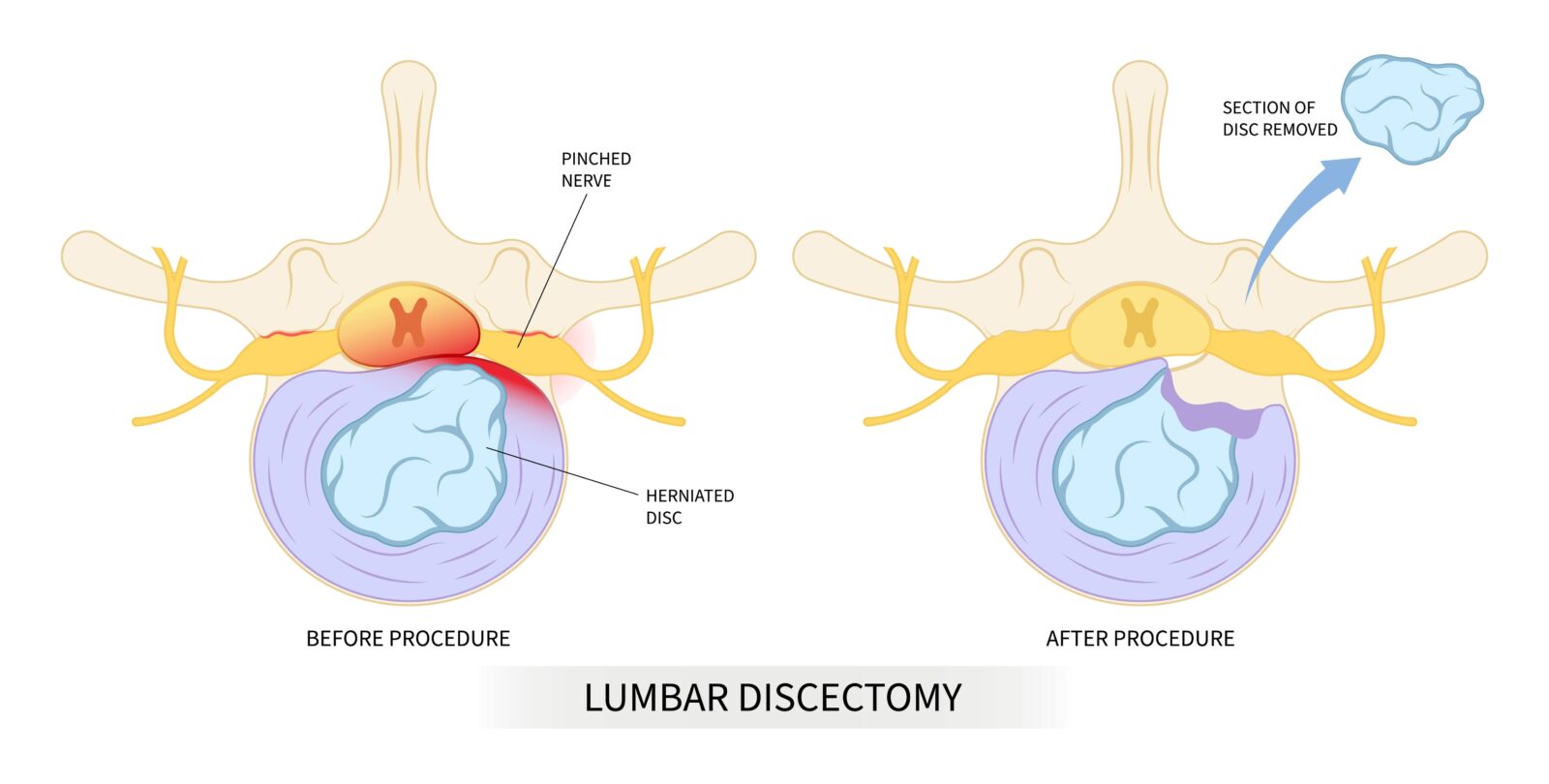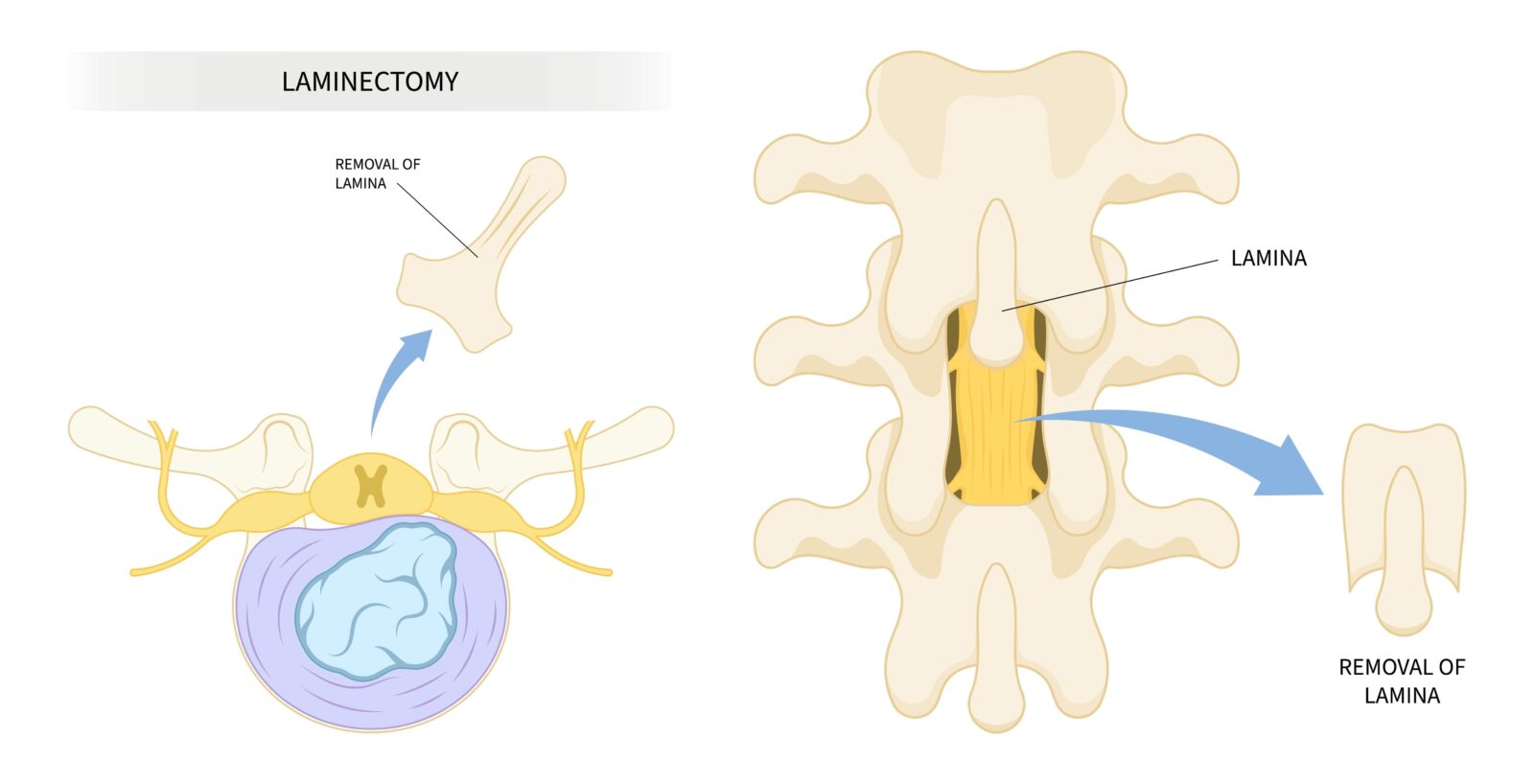Back and neck pain are common ailments that affect millions of people worldwide. When conservative treatments fail to provide relief, surgical options may be considered. Foraminotomy, discectomy, and laminectomy are three common surgical procedures used to address spinal issues. In this blog post, we will delve into the details of these procedures, highlighting their differences and their specific applications.
Foraminotomy:
A foraminotomy is a surgical procedure performed to relieve pressure on the nerves in the spinal column. It specifically targets the intervertebral foramina, which are small openings through which nerves exit the spinal canal. These openings can become narrowed or constricted due to various conditions such as herniated discs, bone spurs, or degenerative disc disease.
The main goal of a foraminotomy is to create more space within the intervertebral foramen, allowing the nerves to exit the spinal canal without being compressed or pinched. The compression of nerves can lead to symptoms such as pain, numbness, tingling, and weakness in the affected areas, which can radiate to the arms or legs depending on the location of the compressed nerves.
During the procedure, the surgeon removes a portion of the bone or tissue that is compressing the nerve roots in the foramen. By widening the foramen, the surgeon aims to alleviate the pressure on the nerves and restore proper nerve function. This can provide relief from symptoms and improve the patient’s quality of life.
Foraminotomy is commonly performed in cases where conservative treatments such as physical therapy, medication, or epidural steroid injections have failed to provide adequate relief. It is often recommended when the nerve compression is localized and confined to a specific area, such as a single level of the spine.
The procedure can be performed using traditional open surgery or minimally invasive techniques. Minimally invasive foraminotomy involves smaller incisions, reduced tissue disruption, and shorter recovery time compared to open surgery. However, the choice of approach depends on the individual patient’s condition and the surgeon’s preference and expertise.
Foraminotomy is considered a relatively safe and effective procedure, with the potential to provide long-term relief from symptoms caused by nerve compression. However, as with any surgical procedure, there are risks involved, including infection, bleeding, nerve injury, or recurrence of symptoms.
It is crucial to consult with a qualified spine specialist or neurosurgeon to determine if foraminotomy is the appropriate treatment option for your specific condition. They will evaluate your symptoms, conduct diagnostic tests, and recommend the most suitable treatment approach to address your spinal issues and alleviate your symptoms.
Discectomy:
A discectomy is a surgical procedure performed to treat conditions affecting the intervertebral discs, which act as cushions between the vertebrae in the spine. The procedure aims to remove a portion or the entire herniated or bulging disc that is causing compression on the nerves in the spinal canal.

The most common reason for a discectomy is a herniated disc, also known as a slipped or ruptured disc. In this condition, the inner gel-like material of the disc, called the nucleus pulposus, protrudes through the outer layer, known as the annulus fibrosus. This herniation can put pressure on nearby nerves, causing pain, numbness, tingling, and weakness in the area supplied by those nerves.
The goal of a discectomy is to alleviate the pressure on the compressed nerves, relieve pain, and restore normal nerve function. The procedure can be performed on different levels of the spine, such as the cervical (neck), thoracic (mid-back), or lumbar (lower back) regions, depending on the location of the herniated disc.
During the procedure, the surgeon typically makes an incision in the affected area of the spine and carefully removes a portion or the entire herniated disc material. The specific technique may vary based on the surgeon’s preference and the characteristics of the herniated disc. In some cases, a minimally invasive approach, such as a microdiscectomy, may be employed, which involves smaller incisions, less tissue disruption, and faster recovery compared to traditional open surgery.
Discectomy is generally recommended when conservative treatments such as rest, physical therapy, medication, or epidural steroid injections have failed to provide relief from symptoms or when there is significant nerve compression causing severe pain, neurological deficits, or impaired quality of life.
By removing the herniated disc material, a discectomy aims to relieve pressure on the nerves, reduce inflammation, and allow the affected nerve roots to heal. It can alleviate symptoms such as radiating pain, numbness, tingling, and weakness in the arms or legs, depending on the location of the herniated disc.
While a discectomy can provide significant relief, it is important to note that it does not address the underlying causes of disc degeneration or prevent the possibility of future disc herniations. Rehabilitation and preventive measures, such as maintaining proper posture, practicing good body mechanics, and participating in regular exercise, may be recommended to reduce the risk of future disc problems.
As with any surgical procedure, there are risks associated with a discectomy, including infection, bleeding, nerve injury, recurrent disc herniation, or spinal instability. It is essential to consult with a qualified spine specialist or neurosurgeon to determine if a discectomy is the appropriate treatment option for your specific condition. They will evaluate your symptoms, conduct diagnostic tests, and recommend the most suitable treatment approach to address your spinal issues and alleviate your symptoms.
Laminectomy:
A laminectomy, also known as decompression surgery, is a surgical procedure performed to relieve pressure on the spinal cord or nerves in the spinal canal. It involves the removal of the lamina, which is the bony plate covering the back of the spinal canal.

The primary goal of a laminectomy is to create more space within the spinal canal, alleviating pressure on the spinal cord or nerves caused by various conditions, such as spinal stenosis, herniated discs, bone spurs, tumors, or spinal deformities.
Spinal stenosis is a common reason for undergoing a laminectomy. It is a condition characterized by the narrowing of the spinal canal, which can compress the spinal cord and nerve roots. This compression can lead to symptoms such as pain, numbness, weakness, and difficulty walking. By removing a portion of the lamina, a laminectomy widens the spinal canal, relieving pressure on the affected structures and reducing symptoms.
A laminectomy may also be performed to address other spinal conditions, such as herniated discs or bone spurs. If a herniated disc or bone spur is pressing against the spinal cord or nerve roots, a laminectomy can be performed to remove the source of compression and provide relief.
Additionally, laminectomy may be recommended to address spinal tumors or cysts that are causing spinal cord or nerve compression. In these cases, the surgeon may remove the lamina to access and remove the tumor or cyst, relieving pressure on the spinal structures.
The procedure can be performed on different levels of the spine, depending on the location of the compression and the underlying condition. It may involve the removal of a single lamina (hemilaminectomy) or multiple laminae (bilateral laminectomy).
Laminectomy can be performed using traditional open surgery or minimally invasive techniques, depending on the specific case and the surgeon’s expertise. Minimally invasive laminectomy involves smaller incisions, reduced muscle and tissue disruption, and potentially faster recovery compared to open surgery.
While a laminectomy can effectively relieve symptoms and improve quality of life, it is important to note that it does not address the underlying cause of the spinal condition. Rehabilitation, physical therapy, and lifestyle modifications may be recommended to manage the underlying condition, prevent further deterioration, and optimize long-term outcomes.
As with any surgical procedure, a laminectomy carries risks, including infection, bleeding, nerve damage, spinal instability, or complications associated with anesthesia. It is crucial to consult with a qualified spine specialist or neurosurgeon to determine if a laminectomy is the appropriate treatment option for your specific condition. They will evaluate your symptoms, conduct diagnostic tests, and recommend the most suitable treatment approach to address your spinal issues and alleviate your symptoms.
Key Differences:
Here’s a table summarizing the key differences between foraminotomy, discectomy, and laminectomy:
| Procedure | Targeted Area | Surgical Technique | Main Purpose | Common Conditions |
| Foraminotomy | Intervertebral Foramina | Bone or Tissue Removal | Relieve pressure on nerves in the spinal column | Herniated discs, bone spurs, DDD |
| Discectomy | Intervertebral Discs | Disc Removal | Remove herniated or bulging disc material | Herniated or ruptured discs |
| Laminectomy | Lamina (Bony Plate) | Lamina Removal | Create more space in the spinal canal | Spinal stenosis, tumors, bone spurs |
Note: Surgical techniques may vary based on the specific case and the surgeon’s preference. Minimally invasive approaches may be used for certain procedures.
These procedures are performed to address different spinal conditions and alleviate symptoms associated with nerve compression or spinal cord impingement. It’s important to consult with a healthcare professional to determine the most appropriate treatment option for your specific condition.
In Conclusion:
Foraminotomy, discectomy, and laminectomy are three distinct surgical procedures used to address different spinal conditions. Each procedure targets specific areas of the spine and aims to relieve pressure on nerves or the spinal cord. If you are experiencing back or neck pain, it is essential to consult with a qualified medical professional to determine the most appropriate treatment option for your specific condition.










